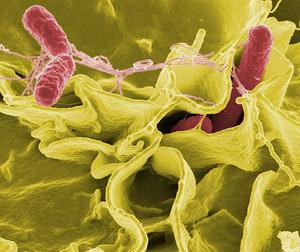Public healthDocs: drug-resistant superbug is "time bomb" requiring global response
Researchers warn that the spread of a drug-resistant bacterial gene could herald the end of antibiotics; the bleak prediction follows his research into a drug-resistant bacterial gene called NDM-1, or New Delhi metallo-beta-lactamase 1, which was first identified in India; the bug was found attached to E.coli bacteria, but the enzyme can easily jump from one bacterium to another and experts fear it will start attaching itself to more dangerous diseases causing them to become resistant to antibiotics

NDM-1 enzyme turns any bacterium into a "superbug" // Source: /inewp.com
A new superbug from India thought to be resistant to nearly every known antibiotic poses a global threat, scientists warned Monday, urging health authorities to track the bacteria.
“There is an urgent need, first, to put in place an international surveillance system over the coming months and, second, to test all the patients admitted to any given health system” in as many countries as possible, said Patrice Nordmann of France’s Bicetre Hospital. “For the moment, we don’t know how fast this phenomenon is spreading… it could take months or years, but what is certain is that is will spread,” he told AFP, noting that measures have already been agreed in France and are under discussion in Japan, Singapore and China. “It’s a bit like a time bomb.”
Nordmann was in Boston for the 50th annual meeting of the Interscience Conference on Antimicrobial Agents and Chemotherapy (ICAAC), the world’s largest gathering of infectious disease specialists, which is drew some 12,000 people here during 12-14 September.
The head of Bicetre’s department of bacteriology and virology said the bacteria will find fertile ground in India’s vast population of 1.3 billion, and could easily be carried back and forth by the country’s widespread diaspora (“NDM-1 may herald the end of antibiotic era,” 13 August 2010 HSNW).
The so-called “superbug,” dubbed NDM-1 (New Delhi metallo-beta-lactamase 1), and its variants appear to have originated in India and were first detected in Britain in 2007.
The NDM-1 is a gene that produces an enzyme that deactivate basically all antibiotics.
After the bug was detected, the number of infected people began to increase, reaching more than 70 in Britain and more than 170 in India and Pakistan.
The bug attracted media attention after the August publication of a research article in Britain’s Lancet journal that said an Indian “medical tourist” appeared to have brought the bacteria to Britain (“Superbug found in British patients returning from treatment in Asia,” 11 August 2010 HSNW).
AFP reports that after the article, cases were reported in Canada, the United States, Belgium, Netherlands, Austria, France, Germany, Kenya, Australia, Hong Kong, and Japan.
A Belgian citizen hospitalized in Pakistan after a car accident was the first known death related to infection by the superbug.
Unlike other multi-drug resistant bugs reported during the last twenty years, NDM “brings several additional factors of deep concern for public health,” said Nordmann.
For example, scientists have determined that the NDM gene “is very mobile, hopping from one bacteria to another,” he said.
Specialists can help “stem the onslaught of DNM producers” through “early identification of the very first cases of NDM-related infections and preventing their spread by implementing screening, hygiene measures and isolation of carriers,” Nordmann said.
Timothy Walsh with Cardiff University in Britain, who first uncovered the gene and wrote the Lancet report, worried that experts did not know how wide the bug had spread in India. “One of the great concerns is the lack of sanitation — more than 600 million people in India don’t have sanitation — and also because of the massive antibiotic use in those countries that can fuel the antibiotic resistance,” Walsh said.
Drug resistance in bacteria, blamed on excessive and improper use of antibiotics, is not new, and health experts warn of an increasingly dangerous environment where the problem can flourish.
